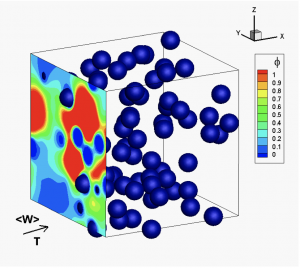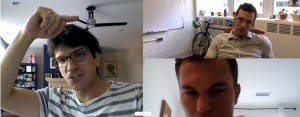“We’ve been collaborating informally, just motivated by the science questions, without any funding for a year or so. As we were working out those science questions, we thought, ‘Hey, we should really move this forward,’” said Shankar Subramaniam, professor of mechanical engineering.
Subramaniam and collaborators from Minnesota and Michigan recently received funding for a three-year National Science Foundation-funded project studying how particle clustering affects heat transfer in a mixture of solids and gases.
Experiments and simulations

Experiments are being conducted by Filippo Coletti at the University of Minnesota with particles falling through a vertical channel to understand their behavior. Rather than creating a uniform, homogeneous configuration, these particles tend to clump together into clusters.
“As you can imagine, if you have a bunch of clusters, then heat doesn’t transfer as easily as it would if they were homogeneously spread apart,” Subramaniam said.
Simulations were created by Jesse Capecelatro at the University of Michigan that modeled the interaction between particles and gas, and they predicted this clustering behavior. This project attempts to recreate similar results for heat transfer, which will be compared to the actual experiments.
Modeling is extremely valuable for efficient computation because doing the calculations for every particle would take far too long. However, developing accurate models for the interaction between particles and gas is greatly benefited by fundamental simulation studies where the detailed interaction between individual particles and gas is computed in smaller domains that are computationally feasible.
Fundamental knowledge concerning heat transfer between solid particles and gas is being discovered through such simulations at Iowa State in Subramaniam’s group to truly understand the process of heat transfer from gas to individual particles in a cluster. The project aims to answer the following questions:
- What is the exact heat transfer at the scale of one particle?
- What happens when these particles clump up?
- How do we model that?

Outreach and education
As part of the proposed NSF project, Subramaniam and his team are planning to create a hands-on toy model that can be used to demonstrate heat transfer to middle school and high school students. The toy will be a version of a fluidized bed, with beads that are sprayed with thermochromic liquid crystals, which change color with temperature.
The outreach aspect of the project fits right into the goal of the Center for Multiphase Flow Research and Education (CoMFRE), which involves educating students, both in college and younger, about flow involving multiple phases.
CoMFRE has had other impacts on this research as well.
“It was CoMFRE that enabled the visits to Iowa State by my collaborators, Filippo Coletti and Jesse Capecelatro,” Subramaniam said. “I think this is the real impact of CoMFRE: that it enables researchers to come together and start working on problems that eventually lead to grant proposals and funded projects.”
Application and versatility
The research conducted by Subramaniam and his team is the first of its kind to simulate with flows of the scale that they are working with. It will be available to the scientific community for use as a fundamental building block that opens up many doors and can be applied to various processes, such as coal combustion, biomass and chemical looping combustion.
Another important application is the capture of carbon dioxide from the gas that is emitted by power plants using particle sorbents in a continuous fluidized bed process.
“The kind of fundamental research we’re doing here, connecting to the researchers at national labs and giving them the tools to model these processes more accurately, is what will get the university’s name on the map in this field,” Subramaniam said.